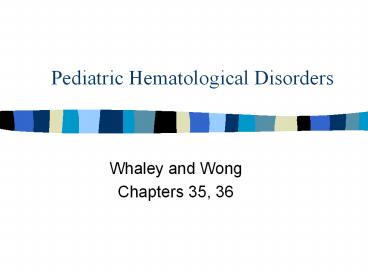Pediatric Hematological Disorders - PowerPoint PPT Presentation
Title:
Pediatric Hematological Disorders
Description:
Pediatric Hematological Disorders Whaley and Wong Chapters 35, 36 Components of the Blood Erythrocytes Problems of Erythrocyte Production Causes of Anemia Iron ... – PowerPoint PPT presentation
Number of Views:61
Avg rating:3.0/5.0
Title: Pediatric Hematological Disorders
1
Pediatric Hematological Disorders
- Whaley and Wong
- Chapters 35, 36
2
Components of the Blood
- Blood
- Plasma
- water, albumin, electrolytes, clotting factors
- Cellular Components
- RBCs, WBCs, Platelets
- All formed in the red bone marrow (after birth)
- In utero- spleen, thymus, liver
- lymphatic system regulates maturation
3
Erythrocytes
- RBCs
- carry hemoglobin which is attached to oxygen-
provides O2 to the tissues - life span 120 days
- manufacture regulated by erythropoetin
- Normal Hematocrit- 35-45
- Normal Hemoglobin- 12-16 grams
4
Problems of Erythrocyte Production
- Anemia reduction of RBC volume or Hgb
concentration below normal - Classifications
- 1. Etiology/Pathophysiology
- causes of RBC/Hgb depletion
- 2. Morphology changes in RBC
- size, shape, and color
5
Causes of Anemia
- Nutritional deficiency iron, folate, B12
- Increased destruction of RBCs sickle
- cell anemia
- Impaired or decreased rate of
- production aplastic anemia
- Excessive blood loss - hemophilia
6
Iron Deficiency Anemia
- Causes
- - inadequate supply of iron
- - impaired absorption
- - blood loss
- - excessive demands for iron reqd for
- growth
- - inability for form Hgb
7
Iron Deficiency Anemia
- Signs and Symptoms due to tissue hypoxia gt lack
of energy, easy fatigability, pallor - Diagnosis CBC with diff, red cell indices (MCV,
MCH, MCHC), iron studies, physical exam - Medical Treatment supplement with ferrous
sulfate (dosages vary with age), dietary
counseling
8
Iron Deficiency Anemia
- Nursing Assessment and Interventions
- - educate parents about nutrition
- - explain laboratory testing
- - teach parents proper administration
- of iron preparations, caution about
- high toxicity of iron
9
Sickle Cell Anemia
- Causes genetic transmission, 2 parents with the
trait have 25 chance of having child with SCD,
found primarily in Blacks, occ Hispanics - Hgb A is partly or completely replaced by Hgb S
- With dehydration,acidosis, hypoxia, and
- temp elevations, Hgb S sickles
10
Sickle Cell Anemia
- Pathophysiology
- - vaso-occlusion from sickled RBCs
- - increased RBC destruction
- - splenic congestion and enlargement
- - hepatomegaly, liver failure
- - renal ischemia, hematuria
- - osteoporosis, lordosis, kyphosis
- - cardiomegaly, heart failure, stroke
11
Sickle Cell Anemia
- Signs/Symptoms
- Exercise intolerance
- Anorexia
- Jaundiced sclera
- Gallstones
- Chronic leg ulcers
- Growth retardation
12
Sickle Cell Anemia
- Diagnosis
- - Sickledex
- - Hgb electrophoresis
- - Stained blood smear
- Vaso-occlusive crisis
- - mild to severe bone pain
- - acute abdominal pain
- - priapism
- - arthralgia
13
Sickle Cell Anemia
- Medical management
- Supportive/symptomatic tx of crises
- - bed rest
- - hydration
- - electrolyte replacement
- - analgesics for pain
- - blood replacement
- - antibiotics
- - oxygen therapy
14
Sickle Cell Anemia
- Nursing care
- Minimize tissue deoxygenation
- Promote hydration
- Minimize crises
- Pain management
- Administering blood transfusions
- Encourage screening and genetic counseling
- Parent education
15
Thalassemia
- Autosomal recessive disorder Greeks,
- Italians, Syrians
- Signs/symptoms microcytic anemia gt
- splenomegaly,jaundice,epistaxis, gout
- Diagnosis Hgb electrophoresis
- Medical Treatment transfusions, chelation
16
Hemophilia
- Factor 8 or factor 9 deficiency
- prolonged bleeding any where in the body!
- Cause X-linked recessive disorder, defects in
platelets and clotting factors - Diagnosis history of bleeding episodes, evidence
of x-linked inheritence, labs - Medical Management Factor VIII concentrate,
DDAVP (vasopressin)
17
Hemophilia
- Nursing care
- Prevent bleeding
- Recognize and control bleeding (RICE)
- - Rest
- - Ice
- - Compression
- - Elevation
- Prevent crippling effects of bleeding
- Client education
18
Idiopathic Thrombocytopenic Purpura
- Causes acquired hemorrhagic disorder of unknown
origin, probably an autoimmune response to
disease-related antigens - Diagnosis platelet count lt 20,000, abnl
- bleeding time and clot retraction
- Signs and Symptoms petechiae, bruising, bleeding
from mucous membranes, prolonged bleeding from
abrasions - Medical management supportive, steroids, Anti-D
antibody, splenectomy
19
Idiopathic Thrombocytic Puerpera
- Nursing Considerations
- Client/Parent teaching
- No contact sports
- No aspirin
- Prevent infection
20
Blood Transfusion
- Complications
- Hemolytic reactions
- - chills, shaking, fever
- - dyspnea
- - flank pain
- - progressive signs of shock
- Febrile reactions
- Allergic reactions
- - urticaria, flushing
- - wheezing
- Circulatory overload
21
Blood Transfusions
- Nursing Care
- Take VS BEFORE administering blood
- Check ID of recipient with donors blood type
- Administer 50 mL or 1/5 volume SLOWLY STAY WITH
THE CHILD - Administer with NS on piggyback set-up
- Use appropriate filter
- Use within 30 mins infuse within 4 hrs
- If reaction suspected Stop the transfusion,
maintain patent IV line with NS, take VS, notify
practitioner































